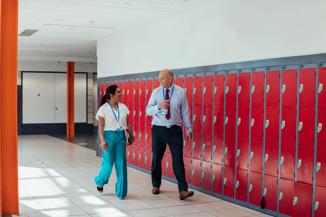It's time for education to embrace flexible working
If NHS staff can request a flexible approach to working patterns then the sector needs to get serious about what it can offer staff, too, if it is to avoid further strain on recruitment and retention.
If NHS staff can request a flexible approach to working patterns then the sector needs to get serious about what it can offer staff, too, if it is to avoid further strain on recruitment and retention.
According to the Institute of Employment Studies (IES) we have a problem in the UK. The labour market is shrinking, leading to most organisations competing for talent more than ever before.
The external marketplace for school staff - leaders, teachers and support staff - is also shrinking.
Clients are telling us that, historically, where they have struggled to recruit leaders and teachers, support staff recruitment was always less of a challenge. That is not the case anymore.
Attracting support staff into schools is incredibly challenging right now.
Perhaps one of the reasons for this is that those who may have chosen to work in education for the school hours are now able to get more lucrative work-from-home jobs in other sectors.
We are also seeing continued challenges as the school workforce has been subject to cuts for years with no change to the workload. Retention is a problem as the work is tough and the grass is looking greener elsewhere.
Being flexible
To counter some of this, the Department for Education recently began a £750,000 programme to aid motivation, maintenance, and recruitment by promoting flexible working in schools and multi-academy trusts (MATS).
This is the right thing to be doing, as flexible working has a huge role to play in school staff retention and recruitment.
According to the latest Workforce Census analysis, fewer headteachers are staying in the role beyond five years of taking up the post, and the number of teachers leaving their jobs last year increased by 12.4 per cent.
We have been talking about the sector having a “leaky bucket” for a while now. A few years ago, we were encouraging a “grow your own” strategy to help deal with the teacher recruitment crisis but now we have fewer support staff entering the sector.
Education has got to start looking at the “employee expectations gap” - the disparity between what staff want from their employment in schools and what is available to them. Clearly, flexible working is a gap that needs filling.
Timewise recently conducted a Teaching Pioneers Programme in eight secondary schools across three MATs, supported by Browne Jacobson.
Its report on the scheme, which got its first airing at the Confederation of Schools Trust conference in Birmingham recently, revealed that most schools are a way off proactively encouraging flexible working. For the sector to continue to attract the best talent, provide working conditions and environments that encourage talent to flourish, and be able to retain that talent in the schools sector at all stages of a person’s life, the approach to flexible working must change.
This article was published in full in the TES magazine, written by our Head of HR Services for Education, Emma Hughes.
Contact

Emma Hughes
Partner
emma.hughes@brownejacobson.com
+44 (0)330 045 2338







































